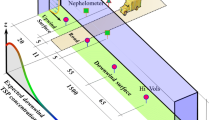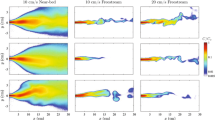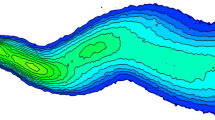Abstract
This article presents the theoretical motivation, implementation approach, and example validation results for a computationally efficient plume simulation model, designed to replicate both the short-term time signature and long-term exposure statistics of a chemical plume evolving in a turbulent flow. Within the resulting plume, the odor concentration is intermittent with rapidly changing spatial gradient. The model includes a wind field defined over the region of interest that is continuous, but which varies with location and time in both magnitude and direction. The plume shape takes a time varying sinuous form that is determined by the integrated effect of the wind field. Simulated and field data are compared. The motivation for the development of such a simulation model was the desire to evaluate various strategies for tracing odor plumes to their source, under identical conditions. The performance of such strategies depends in part on the instantaneous response of target receptors; therefore, the sequence of events is of considerable consequence and individual exemplar plume realizations are required. Due to the high number of required simulations, computational efficiency was critically important.
Similar content being viewed by others
References
Bossert, W.H. and Wilson, E.O.: 1963, The analysis of olfactory communication among animals, J. Theor. Biol. 48, 443–469.
Dusenbery, D.B.: 1992, Sensory Ecology: How Organisms Acquire and Respond to Information, W.H. Freeman, New York.
Vickers, N.J.: 2000, Mechanisms of animal navigation in odor plumes, Biol. Bull. 198, 203–212.
Zimmer, R.K. and Butman, C.A.: 2000, Chemical signaling processes in the marine environment, Biol. Bull. 198, 168–187.
Hassler, A.D. and Scholz, A.T.: 1983, Olfactory Imprinting and Homing in Salmon, Springer-Verlag, New York.
Lohmann, K.J.: 1992, How sea turtles navigate, Sci. Amer. 266, 82–88.
Nevitt, G.A.: 2000, Olfactory foraging by Antarctic procellariiform seabirds: Life at high Reynolds numbers, Biol. Bull. 198, 245–253.
Devine, D.V. and Atema, J.: 1982, Function of chemoreceptor organs in spatial orientation of the lobster, Homarus americanus: differences and overlap, Biol. Bull. 163, 144–153.
Basil, J. and Atema, J.: 1994, Lobster orientation in turbulent odor plumes: simultaneuos measurements of tracking behavior and temporal odor patterns, Biol. Bull. 187, 272–273.
Atema, J.: 1995, Chemical signals in the marine environment: dispersal, detection, and temporal signal analysis, Proc. Natl. Acad. Sci. USA 92, 62–66.
Weissburg, M.J. and Zimmer-Faust, R.K.: 1994, Odor plumes and how blue crabs use them in finding prey, J. Exp. Biol. 197, 349–375.
Mafra-Neto, A. and Cardé, R.T.: 1994, Fine-scale structure of pheromone plumes modulates upwind orientation of flying moths, Nature 369, 142–144.
Cardé, R.T.: 1996, Odour plumes and odour-mediated flight in insects. In: Olfaction in Mosquito-Host Interactions, pp. 54–70, CIBA Found. Symp. 200, John Wiley & Sons.
Cardé, R.T. and Mafra-Neto. A.: 1996, Mechanisms of flight of male moths to pheromone. In: R.T. Cardé and A.K. Minks (eds.), Insect Pheromone Research. New Directions, pp. 275–290, Chapman and Hall, New York.
Grasso, F.W.: 2001, Invertebrate-inspired sensory-motor systems and autonomous, olfactoryguided exploration, Biol. Bull. 200, 160–168.
Arbas, E.A., Willis, M.A. and Kanzaki, R.: 1993, Organization of goal-oriented locomotion: pheromone-modulated flight behavior of moths. In: Beer, R.D., Ritzmann, R.E. and McKenna, T., (eds.), Biological Neural Networks in Invertebrate Neuroethology and Robotics, pp. 159–198, Academic Press, San Diego.
Baker, T.C. and Vickers, N.J.: 1996, Pheromone-mediated flight in moths. In: R.T. Cardé and A.K. Minks (eds.), Insect Pheromone Research. New Directions, pp. 248–264, Chapman and Hall, New York.
Willis, M.A. and Arbas, E.A.: 1996, Active behavior and reflexive responses: Another perspective on odor-modulated locomotion. In: R.T. Cardé and A.K. Minks (eds.), Insect Pheromone Research. New Directions, pp. 304–319, Chapman and Hall, New York.
Witzgall, P.: 1996, Modulation of pheromone-mediated flight in male moths. In: R.T. Cardé and A.K. Minks (eds.), Insect Pheromone Research. New Directions, pp. 265–274, Chapman and Hall, New York.
Kaissling, K.-E.: 1997, Pheromone-controlled anemotaxis in moths. In: Lehrer, M. (ed.), Orientation and Communication in Arthropods, pp. 343–374, Birkhuser Verlag, Basel.
Belanger, J.H. and Willis, M.A.: 1996, Adaptive Control of Odor-Guided Locomotion: Behavioral Flexibility as an Antidote to Environmental Unpredictability, Adaptive Behav. 4, 217–253.
Belanger J.H. and Arbas, E.A.: 1998, Behavioral strategies underlying pheromone-modulated flight in moths: Lessons from simulation studies, J. Comp. Physiol. A 183, 345–360.
Sutton, O.G.: 1947, The problem of diffusion in the lower atmosphere, Quart. J. Roy. Meteorol. Soc. 73, 257-281.
Sutton, O.G.: 1953, Micrometeorology, McGraw-Hill, New York.
Gifford, F.A.: 1960, Peak to average concentration ratios according to a fluctuating plume dispersion model, Int. J. Air Poll. 3, 253–260.
Gifford, F.A.: 1968, An outline of theories of diffusion in the lower layers of the atmosphere. In: D. H. Slade (ed.), Meteorology and Atomic Energy, pp. 65–116, US Atomic Energy Comm.
Briggs, G.A.: 1973, Diffusion estimation for small emissions, ATDL Contributions File No. (Draft) 79, Air Resources Atmospheric Turbulence and Diffusion Laboratory, NOAA, Oak Ridge, Tennessee.
Griffiths, R.F.: 1994, Errors in the use of the Briggs parameterization for atmospheric dispersion coefficients, Atmos. Environ. 28, 2861–2865.
Jones, C.D.: 1983, On the structure of instantaneous plumes in the atmosphere, J. Hazard. Mater. 7, 87–112.
Murlis, J., Elkinton, J.S. and Cardé, R.T.: 1992, Odor plumes and how insects use them, Annu. Rev. Entom. 37, 505–532.
Thomas, M.D.: 1961, Effects of air pollution on plants. In: Air Pollution, p. 442, Columbia University Press, New York.
Elkinton, J.S., Cardé, R.T., and Mason, C.J.: 1984, Evaluation of time-average dispersion models for estimating pheromone concentration in a deciduous forest, J. Chem. Ecol. 10, 1081–1108.
Metais, O.: 1997, Numerical simulation of geophysical turbulence and eddies. In: R.L. Dewar and R.W. Griffiths (eds.), Two-Dimensional Turbulence in Plasmas and Fluids, pp. 37–63, American Institute of Physics.
Terracol, M., Sagaut, P. and Basdevant, C.: 2001, A multilevel algorithm for large-eddy simulation of turbulent compressible flows, J. Comp. Phys. 167, 439–474.
Byers, J.A.: 1996, Temporal clumping of bark beetle arrival at phermone traps: Modeling anemotaxis in chaotic plumes, J. Chem. Ecol. 22, 2133–2155.
Byers, J.A.: 1999, Effects of attraction radius and flight paths on catch of scolytid beetles dispersing outward through rings of pheromone traps, J. Chem. Ecol. 25, 985–1005.
Egan, B.A. and Mahoney, J.R.: 1972, Numerical modeling of advection and diffusion of urban source pollutants, J. Appl. Meteorol. 11, 312–322.
Sykes, R.I. and Henn, D.S.: 1992, Large-eddy simulation of concentration fluctuations in a dispersing plume, Atmos. Environ. 26A, 3127–3144.
Pielke, R.A.: 1994, Mesoscale Meteorological Modeling, Academic Press, San Diego.
Nadaoka, K., Nihei, Y. and Yagi, H.: 1999, Grid-averaged Lagrangian LES model for multiphase turbulent flow. International, J. Multiphase Flow 25, 1619–1643.
Saiki, E.M., Moeng, C.-H. and Sullivan, P.P.: 2000, Large-eddy simulation of the stably stratified planetary boundary layer, Boundary-Layer Meteorol. 95, 1–30.
Gifford, F.A.: 1959, Statistical properties of a fluctuating plume dispersion model. In: F.N. Frankiel and R.A. Shepard (eds.), Advances in Geophysics, Vol. 6, Atmospheric Diffusion and Air Pollution, p. 117, Academic Press, New York.
Elkinton, J.S., Schal, C., Ono, T. and Cardé, R.T.: 1987, Pheromone puff trajectory and upwind flight of male gypsy moths in a forest, Physiol. Entomol. 12, 399-406.
Brady, J.H., Gibson, G. and Packer, M.J.: 1989, Odour movement, wind direction, and the problem of host finding by tsetse flies, Physiol. Entomol. 14, 369–380.
Rumbo, R. and Kaissling, K.-E.: 1989, Temporal resolution of odour pulses by three types of pheromone receptor cells in Antherea polyphemus, J. Comp. Physiol. A. 165, 281–291.
Mafra-Neto, A. and Cardé, R.T.: 1996, Dissection of the pheromone-modulated flight of moths using the single-pulse response as a template, Experientia 52, 373–379.
Aylor, D.E.: 1976, Estimating peak concentrations of pheromones in the forest. In: J.F. Anderson and M.K. Kaya (eds.), Perspectives in Forest Entomology, pp. 177–188. Academic Press.
Aylor, D.E., Parlange, J.-Y. and Granett, J.: 1976, Turbulent dispersion of disparlure in the forest and male gypsy moth response, Environ. Entomol. 5, 1026–1032.
Mylne, K.R.: 1992, Concentration fluctuation measurements in a plume dispersing in a stable surface layer, Boundary-Layer Meteorol. 60, 15–48.
Anonymous: 1968, Meteorological fundamentals for atmospheric transport and diffusion studies. In: D.H. Slade (ed.), Meteorology and Atomic Energy,, pp. 13–63, U.S. Atomic Energy Commission.
Stacey, M.T., Cowen, E.A., Powell, T.M., Dobbins, E., Monismith, S.G. and Koseff, J.R.: 2000, Plume dispersion in a stratified, near-coastal flow: measurements and modeling, Continental Shelf Res. 20, 637–663.
Pasquill, F. and Smith, F.B.: 1983, Atmospheric Diffusion, 3rd edn., Halsted Press, New York.
Luenberger, D.G.: 1979, Introduction to Dynamic Systems, John Wiley, New York.
Jazwinski, A.H.: 1970, Stochastic Processes and Filtering Theory, Academic Press, San Diego.
Roberts, O.F.T.: 1923, The theoretical scattering of smoke in a turbulent atmosphere, Proc. Roy. Soc. A 104, 640–654.
Tang, J.D., Charlton, R.E., Cardé, R.T. and Yin, C.-M.: 1992, Diel periodicity and influence of age and mating on sex pheromone titer in gypsy moth, Lymantria dispar, J. Chem. Ecol. 18, 749–760.
Germano, M., Piomelli, U., Moin, P. and Cabot, W.H.: 1991, A dynamic subgrid-scale eddy viscosity model, Phys. Fluids A 3, 1760–1765.
Moin, P., Squires, K., Cabot, W. and Lee, S.: 1991, A dynamic subgrid-scale model for compressible turbulence and scalar transport, Phys. Fluids A 3, 2746–2757.
Author information
Authors and Affiliations
Rights and permissions
About this article
Cite this article
Farrell, J.A., Murlis, J., Long, X. et al. Filament-Based Atmospheric Dispersion Model to Achieve Short Time-Scale Structure of Odor Plumes. Environmental Fluid Mechanics 2, 143–169 (2002). https://doi.org/10.1023/A:1016283702837
Issue Date:
DOI: https://doi.org/10.1023/A:1016283702837




